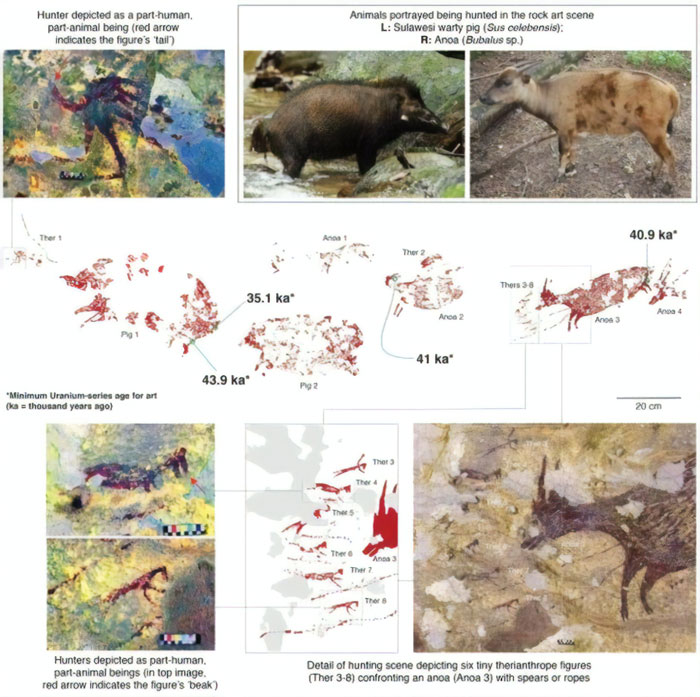
The Newly Discovered 44,000 Y.O. Animal Cave Paintings Tell The Oldest Story On Earth
The historical human legacy may be a niche topic, but it is still nonetheless important. Things we find lying around in the ground are exactly what lets us uncover more of the past that we thought we had lost. In turn, this provides us with new insightful information on what life was like back in the deep past.
Bored Panda has recently covered a message from the past (143 of them, in fact) left by the Nazca people in the Nazca Pampa region, Peru. Well, since then, scientists weren’t lazing around and basking in the glory of their discoveries as they were out busy looking for more discoveries.
Scientists discovered the oldest story told on earth—this is the dwarf buffalo being hunted down by humans
Image credits: Griffith University
A team of archeologists from Griffith University (South East Queensland, Australia) were out studying caves in Sulawesi, Indonesia and stumbled upon some cave drawings that are believed to be over 44,000 years old. Now, it may not be the oldest cave paintings—that would be the bovine in the Lubang Jeriji Saléh cave believed to be as old as 52,000 years old—but what makes this one special is the fact that this cave art tells a story.
Griffith University made it public on their twitter
Image credits: Griffith University
Yes, you’ve read it correctly, the oldest story told on earth. This wall drawing portrays a hunting scenario: a group of half-human, half-animal figures (science calls these therianthropes) attempting to hunt down gigantic mammals—namely a pig and a miniature buffalo—using spears and ropes. The animals were later identified as being the Sulawesi warty pig and the dwarf buffalo, which still exist on the island.
A drawing of a wild pig, later identified as the Sulawesi warty pig
Image credits: Griffith University
Professor Maxime Aubert, Griffith Centre for Social and Cultural Research and the Australian Research Centre for Human Evolution (ARCHE), and Associate Professor Adam Brumm from ARCHE took the lead on the expedition. They were joined by Adhi Agus Oktaviana, an Indonesian rock art expert, and Basran Burhan, a Sulawesian archaeologist, and both Ph.D. students at Griffith University.
The humanoid figures are therianthropes, or shapeshifters, hinting at early Sulawesian religion
Image credits: Griffith University
Scientists claim that this new discovery gives vast insights into the religiousness of these people. As the prehistoric artworks feature therianthropes, or simply put shapeshifters, archaeologists suggest that this may be the oldest proof of the human ability to imagine the supernatural. Nothing like this has ever been seen in the Sulawesi region.
Image credits: Griffith University
Professor Adam Brumm, one of the leaders of the expedition, explained in the Griffith University article that these shapeshifters can be found in nearly all modern society depictions as gods or spirits. This specific one in Sulawesi is now the oldest one of its kind. Previously, the oldest therianthropic depiction found was the lion-man in Germany determined to be 40,000 years old.
The newly discovered cave drawings in their entirety
Image credits: Griffith University
According to Professor Adam Brum in a video Griffith University has released on the matter, the expedition was exploring an area that has been very well-documented and they have been there many times. However, one of the members of the team just happened to look up and noticed a part of a cave that they had never seen before. This is where these ancient artworks were discovered.
Griffith University also provided an explanation of the cave art
Image credits: Griffith University
It is also important to note the fine detail in the cave drawings: the facial features, hoofs, and fur of the buffalo are by no means simplistic, while the giant pig, though faded due to age, has a distinctly detailed form and shape. Until now, it was believed that complex imagery such as this (not just visual detail, but complex story and sophisticated cultural depictions) weren’t around until 35,000 years ago, so this shows how ahead of its time this was.
You can also watch a brief video provided by Griffith University presenting the discovery
Image credits: Griffith University
Amazing indeed!! I'm astonished by the resemblance of these drawings with those in France (Lascaux etc) and Spain. I just wish ppl would stop claiming things to be "the oldest ever" instead of "the oldest so far". What we know by now is that human culture is way older and early humans were developed way higher than than assumed for a long time. And it's pretty sure that other breathtaking things are still to be found one day, we just don't know yet.
Amazing indeed!! I'm astonished by the resemblance of these drawings with those in France (Lascaux etc) and Spain. I just wish ppl would stop claiming things to be "the oldest ever" instead of "the oldest so far". What we know by now is that human culture is way older and early humans were developed way higher than than assumed for a long time. And it's pretty sure that other breathtaking things are still to be found one day, we just don't know yet.










103
11